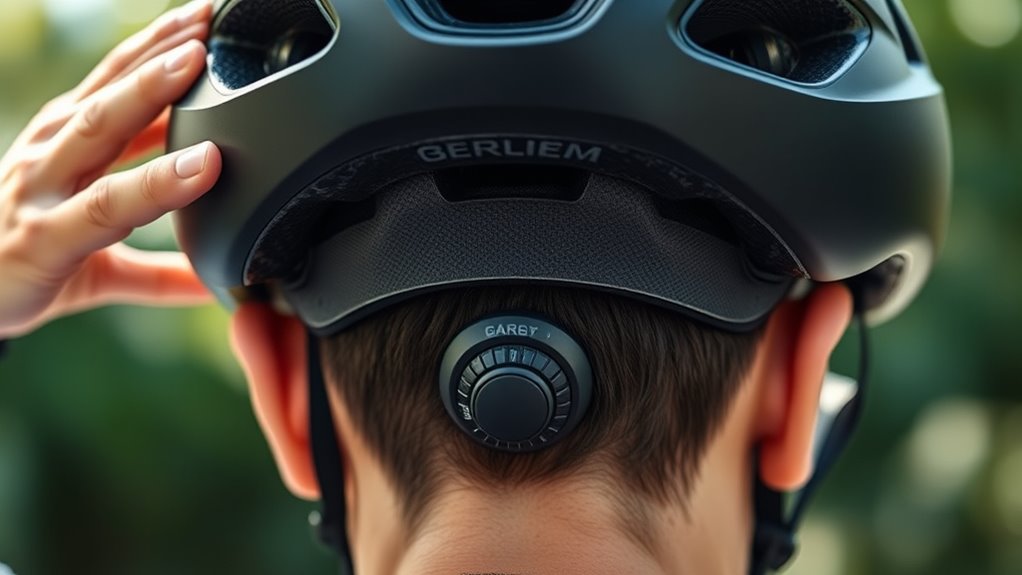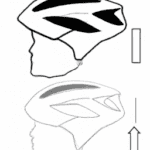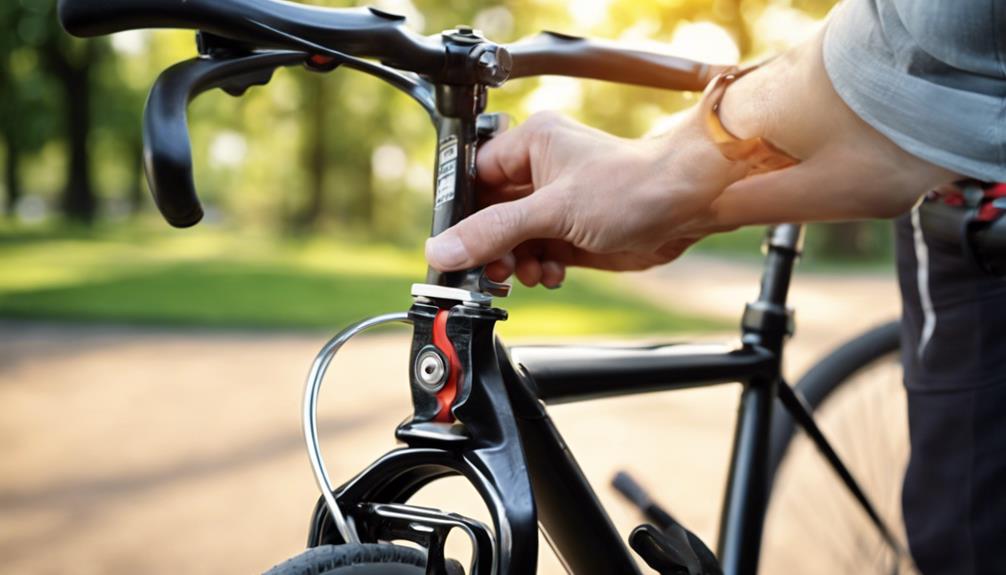To properly fit a bike helmet, start by measuring your head with a flexible tape to find the right size. Place the helmet level above your eyebrows and snug enough so it won’t shift but isn’t too tight. Adjust the straps into a “V” shape under your ears and secure the buckle. Shake your head gently to check stability and comfort. Staying safe means ensuring a perfect fit—you’ll discover more tips to get it just right.
Key Takeaways
- Measure head circumference accurately at a level position above eyebrows and ears, then consult sizing charts for the correct fit.
- Place the helmet level on your head, just above the eyebrows, ensuring it covers the forehead adequately.
- Adjust straps to form a snug “V” under the ears, with only two fingers’ width between strap and chin.
- Perform a fit test by gently shaking your head and opening your mouth wide to check for movement and comfort.
- Regularly recheck the fit and position to ensure maximum protection and comfort during rides.
Measure Your Head Accurately
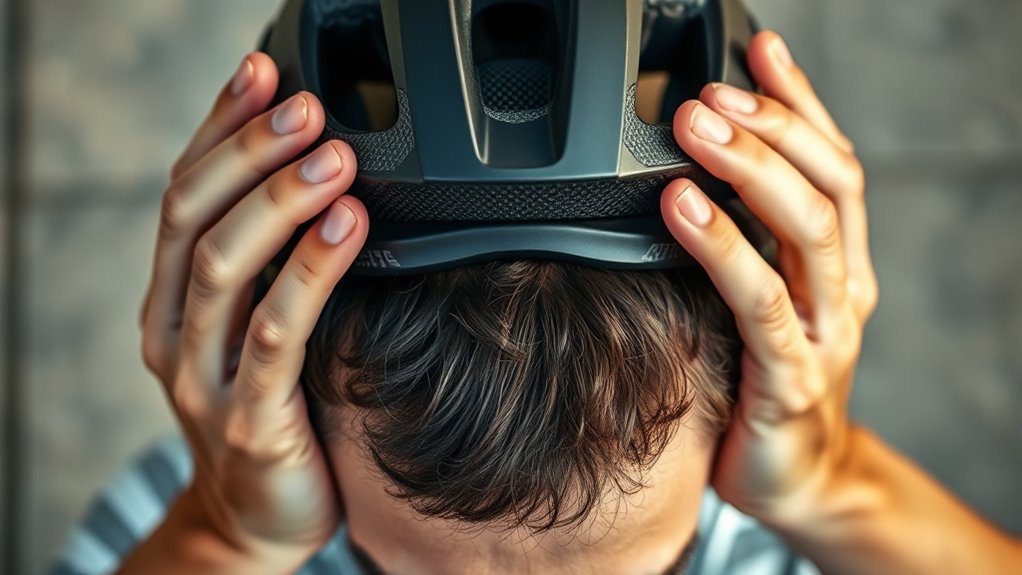
To measure your head accurately, start by wrapping a flexible cloth tape measure or a piece of string around your head. Position it horizontally across your brow and over your ears for the most precise measurement. Make sure the tape is snug but not too tight, staying level around your head. Keep it comfortable so you don’t distort the measurement. It’s a good idea to take multiple measurements around the same area to confirm consistency and accuracy. Once you have your measurement, refer to a helmet size chart to find the right fit. Remember, measuring your head correctly is essential for choosing a helmet that fits properly, providing safety and comfort during your ride. For added comfort, consider proper helmet fit by ensuring there is minimal movement when worn. Additionally, using a well-designed helmet can improve overall safety and ensure proper alignment. Ensuring your helmet is correctly fitted can significantly reduce the risk of injury in case of an accident, especially when combined with a properly adjusted strap.
Select the Correct Helmet Size

Once you have your head measurement, the next step is to select the correct helmet size by consulting the manufacturer’s size chart. This helps you find the right helmet models that match your measurement, whether you fall into Small, Medium, or Large categories. Keep in mind that helmet sizes can vary slightly between brands, so always check the specific brand’s chart before purchasing. Helmet sizes typically range from XS to XL, so precise measurement ensures a snug fit that’s comfortable yet secure. By matching your measurement with the recommended size, you’ll be able to find the right helmet model that offers both comfort and protection on your rides. Incorporating knowledge of helmet fit guidelines can further enhance your safety and comfort, as understanding proper fitting techniques ensures optimal protection. Additionally, paying attention to adjustment straps and ensuring they are snug but not tight can make a significant difference in helmet fit and safety. Ensuring the helmet sits level and covers your forehead adequately is also an important part of helmet fit standards, which contributes to overall safety during your ride. Properly fitted helmets also prevent helmet movement during a crash, providing more reliable protection.
Position the Helmet Properly on Your Head
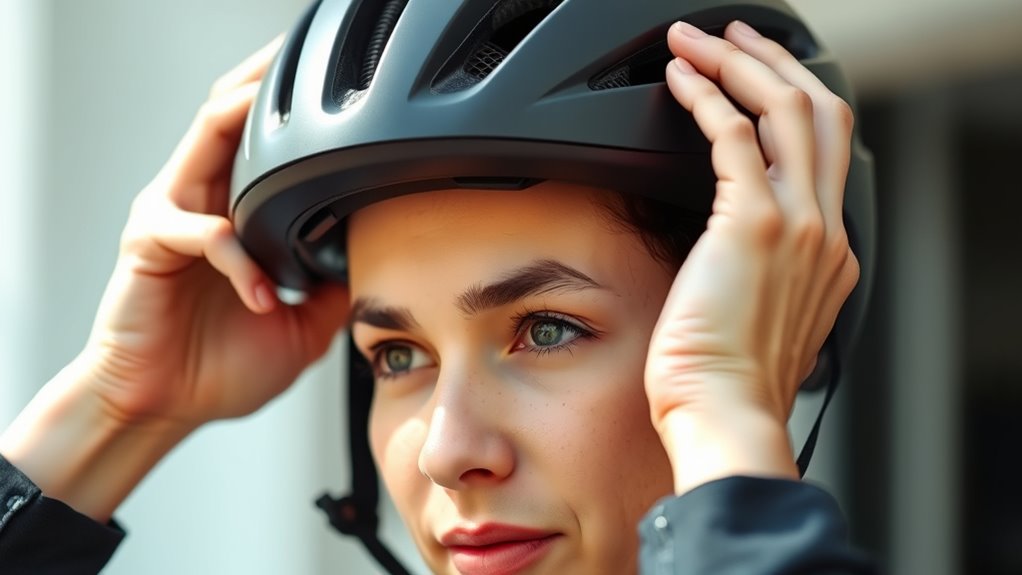
Positioning your helmet correctly is essential for ideal protection and comfort every ride. First, place the right size bike helmet level on your head, sitting just above your eyebrows to cover your forehead adequately. It should be centered front to back and sit evenly without tilting forward or backward. The helmet must fit snugly so it doesn’t wobble or shift when you move your head side to side or up and down. Use the rear fit system or dial to secure a firm, level fit that molds to your head’s shape. Check that the front edge stays just above your eyebrows during movement. Proper positioning ensures maximum coverage and safety, making sure your helmet provides the protection it’s designed for during every ride. Additionally, understanding essential oils for safety and health can help inform safer and more ethical helmet design features in the future. Ensuring the helmet’s proper fit and positioning can also help prevent common issues like pressure points or discomfort during extended rides. A good fit contributes to digital literacy by encouraging proper safety habits, especially for children learning to ride. Proper fit is especially important for remote workers who may spend extended periods in one position, highlighting the importance of comfortable gear.
Adjust and Secure the Straps Correctly
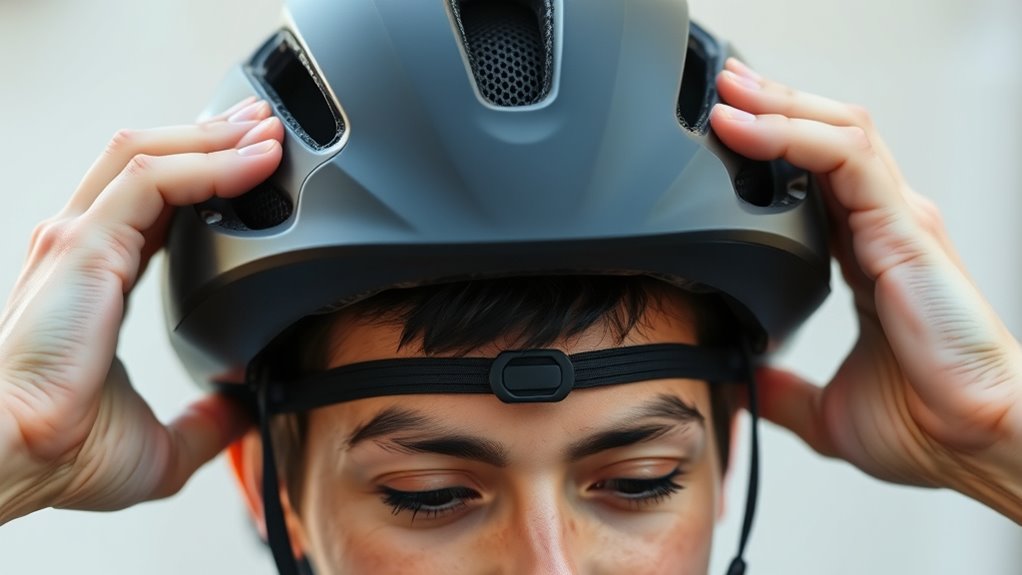
Adjusting and securing your helmet straps correctly is essential for safety and comfort. Make sure the straps form a snug fit under your ears, creating a “V” shape. Thread the chinstrap buckle and click it into place securely. Tighten the strap so that only two fingers fit between the strap and your chin, ensuring comfort without looseness. Tuck any excess strap into the keeper to prevent flapping during your ride. Perform a fit test by opening your mouth wide; the helmet should press against the top of your head without shifting. Proper strap adjustment enhances overall helmet safety and helps prevent injuries in case of an accident. Ensuring the straps are correctly adjusted can also improve overall helmet comfort during your ride. Proper strap fit can also contribute to protective gear effectiveness, making sure your helmet performs as intended during impacts. Additionally, maintaining the correct strap tension can prevent helmet movement during sudden stops or falls. Regularly inspecting your straps for signs of wear can help maintain helmet integrity and ensure continued protection. Here’s a quick overview of proper strap adjustment:
| Step | Action | Result |
|---|---|---|
| Thread & click buckle | Secure the chinstrap | Keeps helmet in place |
| Adjust strap length | Make a “V” shape under your ears | Good fit and comfort |
| Tuck excess strap | Into keeper to prevent interference | Safe and secure fit |
Test the Fit and Make Final Adjustments
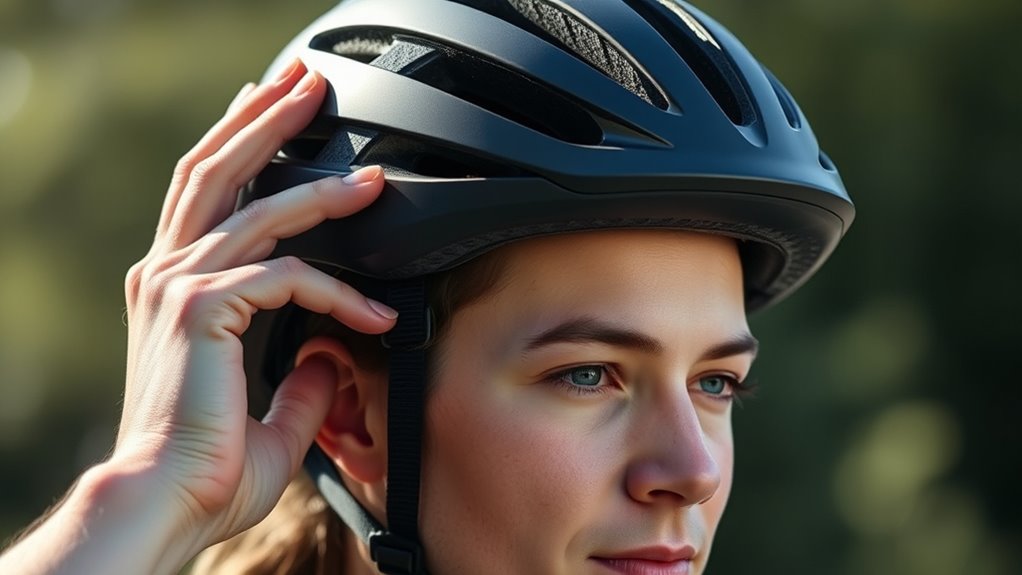
After securing the straps, it’s important to test the helmet’s fit by gently moving it side-to-side and front-to-back. When the helmet on your head is properly fitted, it should shift no more than one inch in any direction. Use a tape measure if needed to gauge this movement, ensuring it sits snugly without feeling too tight. Confirm that the helmet is level on your head, just above your eyebrows, without tilting forward or backward. Check that it feels comfortable and doesn’t pinch or create pressure points. The straps should be snug enough so that only two fingers fit between your chin and the strap. Tuck any excess chinstrap into the keeper, keeping it flat against your head and free of slack or flapping. Remember that a well-fitted helmet can also help reduce injuries if you fall, making proper adjustment even more important.
Secure Excess Chinstrap and Final Checks

Once you’ve secured the chinstrap snugly, tuck any excess length into the keeper or strap management system to prevent flapping while you ride. On the right bike, especially during mountain biking, a secure fit is vital for safety. Leave at least one inch of strap past the buckle to guarantee an adjustable, secure fit. For added durability, carefully melt the cut end of the chinstrap with a lighter or heat source to prevent fraying—just be cautious around the helmet. Confirm the chinstrap is snug enough to fit two fingers’ width between the strap and your chin, providing comfort and safety. Proper wall organization can also help keep your helmet area tidy and accessible. Finally, recheck that the helmet remains level and properly positioned. These final checks help assure your helmet offers maximum protection during every ride.
Frequently Asked Questions
How Is a Bike Helmet Supposed to Fit?
You might wonder how a bike helmet should fit. It needs to sit level on your head, covering your forehead just above your eyebrows. You should feel a snug fit without discomfort, with no gaps between your scalp and the helmet. Adjust the retention system so it’s secure, allowing minimal movement. Straps should form a comfortable “V” under your ears and be tight enough that only two fingers fit under your chin.
What Is the 2 2 2 Rule When Fitting a Helmet on Your Head?
Imagine a perfectly balanced scale—this is what the 2-2-2 rule aims for when fitting your helmet. It means your helmet sits level, covering your forehead just above your eyebrows, with straps forming a “V” around your ears. You snugly secure the chin strap, leaving just enough space for two fingers under your chin. This rule helps you achieve a secure, comfortable fit that protects you during every ride.
How Do You Know When Your Helmet Is Fitted Correctly?
When you check if your helmet is fitted correctly, make certain it sits level on your head, covering your forehead just above your eyebrows. It should feel snug but comfortable, with only two fingers’ width under the chin strap. The helmet shouldn’t move more than an inch side-to-side or front-to-back, and the straps should form a comfortable V under your ears. When you move, it should stay securely in place without wobbling.
What Is the Rule for Helmet Fitting?
They say, “A stitch in time saves nine,” and when it comes to helmet fitting, timing is everything. The rule is that your helmet should sit level on your head, covering your forehead just above your eyebrows, and fit snugly without being tight. It shouldn’t move more than an inch side-to-side or front-to-back. Make sure the chin strap is secure, forming a comfortable V under your ears.
Conclusion
A well-fitted helmet is your shield against life’s unexpected bumps, like a sturdy crown protecting a king. When you wear it right, it becomes more than gear—it’s a symbol of your commitment to safety and confidence. Secure it properly, and it’ll sit like a loyal guardian, ready to face the road ahead. Remember, a helmet that fits perfectly isn’t just protection; it’s your personal lighthouse guiding you safely through every ride.
